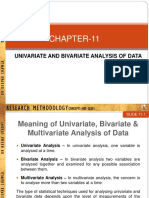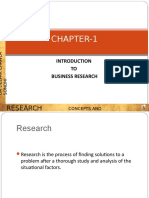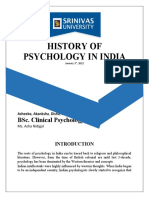CH 6
CH 6
Uploaded by
Rahul A PillaiCopyright:
Available Formats
CH 6
CH 6
Uploaded by
Rahul A PillaiOriginal Description:
Original Title
Copyright
Available Formats
Share this document
Did you find this document useful?
Is this content inappropriate?
Copyright:
Available Formats
CH 6
CH 6
Uploaded by
Rahul A PillaiCopyright:
Available Formats
DR NEENA SONDHI
CHAPTER-6
QUALITATIVE METHODS OF DATA COLLECTION
DR DEEPAK CHAWLA
RESEARCH METHODOLOGY CONCEPTS AND CASES
DR NEENA SONDHI SLIDE 6-1
Qualitative data collection methods
Qualitative methods of data collection explore the
latent and the unconscious constructs through
various means that are loosely structured and
require in-depth and closer exploration and
DR DEEPAK CHAWLA
reporting of phenomena or behavior, which would
not be apparent through more structured methods.
RESEARCH METHODOLOGY CONCEPTS AND CASES
SLIDE 6-2
Classification of qualitative methods
DR NEENA SONDHI
Qualitative Research
Procedures
Direct Indirect
(Nondisguised) (Disguised)
Observation Focus Depth Content
Groups Interviews Analysis
DR DEEPAK CHAWLA
Projective Sociometry New
Techniques
Association Completion Construction Expressive Choice /
Techniques Techniques Techniques Techniques Ordering
RESEARCH METHODOLOGY CONCEPTS AND CASES
SLIDE 6-3
Qualitative vs quantitative methods
DR NEENA SONDHI
Research stage Qualitative Quantitative
Study objective Exploratory, investigative Definite, conclusive and
predictive
Research design Loosely structured Structured, controlled
conditions
Sampling plan Small samples Large/representative
DR DEEPAK CHAWLA
samples
Type of approach Loosely structured Formatted & structured
Data analysis Textual and non-statistical Statistically tested and
authenticated
Study deliverables Explanatory and supportive Conclusive and action
oriented
RESEARCH METHODOLOGY CONCEPTS AND CASES
SLIDE 6-4
Observation method
DR NEENA SONDHI
Observation involves viewing and recording individuals,
groups, organizations or events in a scientific manner in
order to collect valuable data related to the topic under
study.
Method format:
DR DEEPAK CHAWLA
Standardized and structured
Non-standardized and unstructured
RESEARCH METHODOLOGY CONCEPTS AND CASES
SLIDE 6-5
Observation method
DR NEENA SONDHI
Level of respondent consciousness
Disguised observation
Undisguised observation
Observation setting
Natural environment
DR DEEPAK CHAWLA
Simulated environment
Role of the human participant
Participating
Non-participating
RESEARCH METHODOLOGY CONCEPTS AND CASES
SLIDE 6-6
Mechanical observation method
DR NEENA SONDHI
Store scanners and store cameras
Audio and people meters
Psycho galvanometer
DR DEEPAK CHAWLA
Oculometers
Pupilometers
Voice pitch meters
RESEARCH METHODOLOGY CONCEPTS AND CASES
SLIDE 6-7
Observation guide(sample sheet)
DR NEENA SONDHI
DR DEEPAK CHAWLA
RESEARCH METHODOLOGY CONCEPTS AND CASES
SLIDE 6-8
Content Analysis
DR NEENA SONDHI
Content analysis technique involves studying a
previously recorded or reported communication and
systematically and objectively breaking it up into more
manageable units that are related to the topic under
study.
Material studied is usually ex-post facto.
DR DEEPAK CHAWLA
Study and analysis is, however, primary and problem
specific.
RESEARCH METHODOLOGY CONCEPTS AND CASES
SLIDE 6-9
Content Analysis
DR NEENA SONDHI
Universe of content
Word
Theme
Character
DR DEEPAK CHAWLA
Space measures
Time measures
Item
RESEARCH METHODOLOGY CONCEPTS AND CASES
SLIDE 6-10
Content Analysis
DR NEENA SONDHI
Validating the findings
Obtaining the analysis from multiple evaluators and cross
validating using the following formula
DR DEEPAK CHAWLA
Pr (a) = the relative observed agreement between the two
raters
Pr (e) = the probability that this is due to chance.
If the two raters are in complete agreement then Kappa is =1. If
there is no agreement then Kappa=0, 0.21-0.40 is fair, 0.41-
0.80 is good and 0.81-1.00 is considered as excellent.
RESEARCH METHODOLOGY CONCEPTS AND CASES
SLIDE 6-11
Focus group discussion
DR NEENA SONDHI
A focus group discussion involves collecting information
from a representative group of respondents in a neutral
setting. The process generally involves a moderator
who maneuvers the discussion on the topic under
study.
It is essentially a sociological technique.
DR DEEPAK CHAWLA
The group dynamics influence the individual to
respond in divergent ways.
RESEARCH METHODOLOGY CONCEPTS AND CASES
DR NEENA SONDHI SLIDE 6-12
Key elements of focus group method
Size: Ideal recommended size for a group discussion is
8 to 12 members.
Nature: Composition of the group should be homogenous-
in terms of demographic and psychographic traits and
product/subject knowledge.
It is
DR DEEPAK CHAWLA
Acquaintance: recommended that the members in a group
should be strangers to each other.
Setting: Discussion setting should be neutral, informal and
comfortable.
RESEARCH METHODOLOGY CONCEPTS AND CASES
SLIDE 6-13
Key elements of
DR NEENA SONDHI
Focus Group discussion(FGD)
Time period: usually recommended that the
discussion should take place in a single setting.
Recording: human or mechanical recording of the
entire discussion.
DR DEEPAK CHAWLA
Moderator: key conductor, might be a participant or a
non-participant.
RESEARCH METHODOLOGY CONCEPTS AND CASES
DR NEENA SONDHI SLIDE 6-14
Key moderator skills
Listening skills
Observation skills
Flexibility of approach
DR DEEPAK CHAWLA
Empathetic yet objectivity of conduction
Summary and closure approach
RESEARCH METHODOLOGY CONCEPTS AND CASES
DR NEENA SONDHI SLIDE 6-14
Planning & Conducting FGDs
Define the research objective(s) requiring discussion
Split and bulleted into information areas
Identifying the respondent screening/selection criteria
DR DEEPAK CHAWLA
Conducting the FGD
Summarizing the findings of the FGD
RESEARCH METHODOLOGY CONCEPTS AND CASES
SLIDE 6-15
Stages in group formation
DR NEENA SONDHI
DR DEEPAK CHAWLA
RESEARCH METHODOLOGY CONCEPTS AND CASES
SLIDE 6-15
Sample FGD guide
DR NEENA SONDHI
DR DEEPAK CHAWLA
RESEARCH METHODOLOGY CONCEPTS AND CASES
SLIDE 6-15
Types of focus groups
DR NEENA SONDHI
Two-way focus group
Dual moderator group
Fencing moderator group
Friendship group
Mini-groups
DR DEEPAK CHAWLA
Creativity groups
Brand-obsessive groups
Online focus groups
RESEARCH METHODOLOGY CONCEPTS AND CASES
DR NEENA SONDHI SLIDE 6-15
Focus group discussions
Advantages Disadvantages
Idea generation Group dynamics
Group dynamics Scientific process
DR DEEPAK CHAWLA
Statistical analysis
Process advantage
Moderator/investigator
Reliability & validity
bias
RESEARCH METHODOLOGY CONCEPTS AND CASES
SLIDE 6-16
Personal interview method
DR NEENA SONDHI
The personal interview is a one to one interaction
between the investigator/interviewer and the
interviewee. The purpose of the dialogue is research
specific and ranges from completely unstructured to
highly structured
DR DEEPAK CHAWLA
Typical Usage:
Problem definition
Exploratory research
Primary data collection
RESEARCH METHODOLOGY CONCEPTS AND CASES
SLIDE 6-17
Conducting the personal interview
DR NEENA SONDHI
Stating the interview objective
Identifying the interview guidelines: unstructured,
semi-structured or structured.
DR DEEPAK CHAWLA
Screening the interviewees
Analysis and interpretation of interview data
RESEARCH METHODOLOGY CONCEPTS AND CASES
SLIDE 6-18
Sample interview guide
DR NEENA SONDHI
DR DEEPAK CHAWLA
RESEARCH METHODOLOGY CONCEPTS AND CASES
DR NEENA SONDHI SLIDE 6-18
Categorization of personal interviews
Interview Methods
Telephone Personal
Interviewing Interviewing
DR DEEPAK CHAWLA
Traditional Computer – In-Home Mall Computer –
Assisted Intercept Assisted
RESEARCH METHODOLOGY CONCEPTS AND CASES
DR NEENA SONDHI SLIDE 6-19
Categorization of personal interviews
Personal methods: these include at-home
interviews, mall-intercept interviews, computer
assisted personal interviews.
DR DEEPAK CHAWLA
Telephone methods: these include traditional
telephonic interviews, computer assisted
telephonic interviews.
RESEARCH METHODOLOGY CONCEPTS AND CASES
DR NEENA SONDHI SLIDE 6-20
Projective techniques
Projective techniques involve indirect questioning. The
respondent is given a relatively ambiguous stimuli and
the underlying assumption is that the respondents
would project their underlying needs, emotions, beliefs
and attitudes on to this object .
Association techniques
DR DEEPAK CHAWLA
Completion techniques
Construction techniques
Choice or ordering techniques
Expressive techniques
RESEARCH METHODOLOGY CONCEPTS AND CASES
DR NEENA SONDHI SLIDE 6-21
Sociometric analysis
Sociometry involves measuring the choice,
communication and interpersonal relations of people in
different groups. The computations made on the basis
of these choices indicate the social attraction and
avoidance in a group.
Sociometric measures
DR DEEPAK CHAWLA
Sociometric indices
Sociometric matrix
Sociogram
RESEARCH METHODOLOGY CONCEPTS AND CASES
DR NEENA SONDHI SLIDE 6-22
Sociometric matrix(team choices)
Nimit Shanti Pooja Ravdeep Asmit Rini
Nimit 0 1 1 0 0 0
Shanti 1 0 0 0 1 0
Pooja 1 1 0 0 0 0
Ravdeep 0 1 0 0 1 0
Asmit 0 1 0 0 0 1
Rini 0 1 0 0 1 0
DR DEEPAK CHAWLA
∑ 2 5 1 0 2 1
RESEARCH METHODOLOGY CONCEPTS AND CASES
DR NEENA SONDHI
END OF CHAPTER
DR DEEPAK CHAWLA
RESEARCH METHODOLOGY CONCEPTS AND CASES
You might also like
- AdmissionLetter - 23070900177 GLA UniversityDocument2 pagesAdmissionLetter - 23070900177 GLA UniversityAyush AryanNo ratings yet
- Cluster AnalysisDocument19 pagesCluster AnalysissairamNo ratings yet
- Mla Example BullyingDocument6 pagesMla Example Bullyingapi-28553089667% (3)
- CH 2Document14 pagesCH 2Shilpa Sulekh33% (3)
- Chapter-5: Research MethodologyDocument17 pagesChapter-5: Research MethodologyShilpa SulekhNo ratings yet
- Descriptive StatisticsDocument25 pagesDescriptive StatisticssairamNo ratings yet
- Harvest Gold: Delhi's No. 1 Bread: Management CaseDocument17 pagesHarvest Gold: Delhi's No. 1 Bread: Management CaseRounak TaunkNo ratings yet
- Chapter-9: Research MethodologyDocument11 pagesChapter-9: Research MethodologyInd RA JeetNo ratings yet
- ch-9-ppt Sampling ConsiderationDocument11 pagesch-9-ppt Sampling ConsiderationBalagovind SNo ratings yet
- Ch.3 ResDes Exp DescDocument12 pagesCh.3 ResDes Exp DescSangamesh BagaliNo ratings yet
- Ch.8-QuestnrDesgn Prashant CDocument27 pagesCh.8-QuestnrDesgn Prashant CSangamesh BagaliNo ratings yet
- Chapter-4: Research MethodologyDocument30 pagesChapter-4: Research MethodologyShilpa Sulekh0% (1)
- Cluster AnalysisDocument19 pagesCluster Analysissairam100% (1)
- CH 1Document16 pagesCH 1Dinesh SathasivamNo ratings yet
- CH 3Document11 pagesCH 3Shilpa Sulekh100% (1)
- Research MethodologyDocument16 pagesResearch MethodologyshamilyjaggiNo ratings yet
- ch.10 - Data AnalysisDocument21 pagesch.10 - Data AnalysisSuresh PanmandNo ratings yet
- Ch.3 - Research DesignsDocument10 pagesCh.3 - Research Designsharsh pandit0% (1)
- Factor AnalysisDocument16 pagesFactor AnalysissairamNo ratings yet
- Ch1 PPT Research MethodologyDocument16 pagesCh1 PPT Research MethodologySultan AnsariNo ratings yet
- CH 7Document26 pagesCH 7Prabhleen KaurNo ratings yet
- Single PopulationDocument25 pagesSingle PopulationJai GuptaNo ratings yet
- Chapter-10: Research MethodologyDocument21 pagesChapter-10: Research MethodologyPrashant KumbarNo ratings yet
- CH 9Document11 pagesCH 9Arnold Sargunam100% (4)
- Ch-2 Formulation of Research ProblemDocument14 pagesCh-2 Formulation of Research ProblemRaval JayNo ratings yet
- Module 3 A Measurement and ScalingDocument26 pagesModule 3 A Measurement and ScalingShivam singhNo ratings yet
- Chapter-15: Research MethodologyDocument25 pagesChapter-15: Research MethodologysairamNo ratings yet
- HypothesisDocument25 pagesHypothesisRohit Verma100% (2)
- Advances in Banking Technology and Management (2008) PDFDocument381 pagesAdvances in Banking Technology and Management (2008) PDFRoxana C. LiviaNo ratings yet
- BRM-Statistics in ResearchDocument30 pagesBRM-Statistics in ResearchAdityaNo ratings yet
- EXIMDocument17 pagesEXIMTrichy MaheshNo ratings yet
- RSDQ ModelDocument2 pagesRSDQ Modelrahulpillai91100% (1)
- CHP 4 Organisational AppraisalDocument18 pagesCHP 4 Organisational AppraisalJeevan GaddameediNo ratings yet
- Accounting Standard 5Document11 pagesAccounting Standard 5Payal Malik100% (1)
- On RfaDocument14 pagesOn RfaSatheshaNo ratings yet
- Tls Summer Internship Job DescriptionDocument7 pagesTls Summer Internship Job DescriptionPrashant AgiwaleNo ratings yet
- Free Download Here: Human Resource Management Aswathappa PDFDocument2 pagesFree Download Here: Human Resource Management Aswathappa PDFSharma GNo ratings yet
- Test of HypothesisDocument10 pagesTest of Hypothesisthemanishgaur100% (1)
- A Summer Training Project Report On: "Training and Devlopment at Surya Roshni LTD."Document8 pagesA Summer Training Project Report On: "Training and Devlopment at Surya Roshni LTD."buddysmbdNo ratings yet
- Practical Exercise 8 - SolutionDocument3 pagesPractical Exercise 8 - SolutionmidoriNo ratings yet
- CB ModelsDocument37 pagesCB ModelspraveenaNo ratings yet
- Projective Technique: Business Research MethodsDocument25 pagesProjective Technique: Business Research MethodsSandhya DubeyNo ratings yet
- BRM NotesDocument99 pagesBRM Notesshubham tikekarNo ratings yet
- Shivangi Shukla AP GPDocument36 pagesShivangi Shukla AP GPgaurav pandeyNo ratings yet
- Business Research Methods Chapter 04Document4 pagesBusiness Research Methods Chapter 04Soumya Jyoti BhattacharyaNo ratings yet
- Internship ReportDocument75 pagesInternship Reportgyanprakashdeb302No ratings yet
- NTCC PPT Final ReportDocument21 pagesNTCC PPT Final ReportAakriti NegiNo ratings yet
- UBS Placements 2020 Final 05.05.2020Document13 pagesUBS Placements 2020 Final 05.05.2020DR DEEPAK KAPURNo ratings yet
- GHRM ppt-1Document20 pagesGHRM ppt-1Khizer PashaNo ratings yet
- A Study On Pricing OptimizationDocument10 pagesA Study On Pricing OptimizationLALITH PRIYANNo ratings yet
- Organizational Behaviour Chapter 3 Udai PareekDocument8 pagesOrganizational Behaviour Chapter 3 Udai PareekRushabh VoraNo ratings yet
- Case Studies Mba 1 AssignmentDocument2 pagesCase Studies Mba 1 Assignmentayushi aggarwalNo ratings yet
- White Paper On RegressionDocument14 pagesWhite Paper On RegressionAshish MaheshwariNo ratings yet
- Includes Years Solv Ed Exam Ques Tions: Book DescriptionDocument2 pagesIncludes Years Solv Ed Exam Ques Tions: Book DescriptionDreamtech Press100% (1)
- Statistical Analysis: Session 2: Measures of Central TendencyDocument41 pagesStatistical Analysis: Session 2: Measures of Central Tendencypriyankamodak100% (1)
- Qualitative Data Collection MethodsDocument29 pagesQualitative Data Collection MethodsKRUPALI RAIYANINo ratings yet
- ch.6 - QUALITATIVE METHODS OF DATA COLLECTIONDocument29 pagesch.6 - QUALITATIVE METHODS OF DATA COLLECTIONharsh pandit100% (1)
- Chapter-6: Research MethodologyDocument29 pagesChapter-6: Research MethodologyKanishka DhingraNo ratings yet
- Chapter-1: Research MethodologyDocument45 pagesChapter-1: Research MethodologyAntony AsnaNo ratings yet
- UNIT 4.1 - ppt-convertedDocument34 pagesUNIT 4.1 - ppt-convertedmehravansh588No ratings yet
- Ch. 2 - Formulation of The Research ProblemDocument10 pagesCh. 2 - Formulation of The Research Problemharsh panditNo ratings yet
- Jungian Archetypes LexiconDocument20 pagesJungian Archetypes LexiconGladys Rios100% (1)
- Does Motivation Affect Performance Via PersistenceDocument17 pagesDoes Motivation Affect Performance Via PersistenceAdi AdunNo ratings yet
- Research MethodsDocument16 pagesResearch MethodsAlexandraMu92No ratings yet
- Staff Development Programme PaedsDocument62 pagesStaff Development Programme PaedsMeena Koushal100% (1)
- Characterististics of Formal and Informal Education, OrganizationDocument5 pagesCharacterististics of Formal and Informal Education, OrganizationEaron Rean SantiagoNo ratings yet
- Hps 405 Pecha KuchaDocument21 pagesHps 405 Pecha Kuchaapi-557881621No ratings yet
- Rps CcuDocument7 pagesRps CcuJalo DoankNo ratings yet
- PR2 Chapter 2Document3 pagesPR2 Chapter 2SHERLYN MACADANGDANGNo ratings yet
- Scott A. Miller-Parenting and Theory of Mind-Oxford University Press (2016)Document369 pagesScott A. Miller-Parenting and Theory of Mind-Oxford University Press (2016)Lacatus Olimpiu100% (1)
- Serial-Position EffectDocument6 pagesSerial-Position Effectisbro1788No ratings yet
- Callista Roy Adaptation TheoryDocument11 pagesCallista Roy Adaptation Theoryandre_delitua100% (6)
- Three Modelsof Emotional IntelligenceDocument4 pagesThree Modelsof Emotional IntelligenceFrancine LuceñaraNo ratings yet
- Importance of Effective Orientation and On BoardingDocument12 pagesImportance of Effective Orientation and On BoardingRobin Hull100% (1)
- Psychology AssignmentDocument19 pagesPsychology AssignmentSTÏNG like a BëeNo ratings yet
- Final 1-5 Experimental Thesis (Ginagawa Pa Lang)Document17 pagesFinal 1-5 Experimental Thesis (Ginagawa Pa Lang)Feloryne De BelenNo ratings yet
- 500 Words July 2018 Iceberg of IgnoranceDocument3 pages500 Words July 2018 Iceberg of IgnoranceOusama FerjeniNo ratings yet
- Technical Paper QuestionnaireDocument5 pagesTechnical Paper QuestionnaireAngel LyricsNo ratings yet
- OBE Individual AssignmentDocument9 pagesOBE Individual Assignmentdoanhiengiang22No ratings yet
- You've Probably Been Involved in A Team-Building Activity at Some PointDocument14 pagesYou've Probably Been Involved in A Team-Building Activity at Some PointJing Ze100% (1)
- Tests of Measurement and Quality: Neena.K.M. DcmsDocument16 pagesTests of Measurement and Quality: Neena.K.M. Dcmsneenakm22No ratings yet
- Chapter 2 - Notes PDFDocument19 pagesChapter 2 - Notes PDFMesay BarekewNo ratings yet
- Basic Criteria For Job RecruitmentDocument1 pageBasic Criteria For Job RecruitmentAnka Mihai - AlisieNo ratings yet
- Brain Lesson Jones PDFDocument7 pagesBrain Lesson Jones PDFFaizan MakhdoomNo ratings yet
- Mid Term Edu402 by PariDocument26 pagesMid Term Edu402 by PariRanaFarhanNo ratings yet
- 10 Strategies For Better Time Management - Burke County ExtensionDocument3 pages10 Strategies For Better Time Management - Burke County ExtensionAntonio VaughnNo ratings yet
- Assignment Cover Page (Theory) Assignment NoDocument8 pagesAssignment Cover Page (Theory) Assignment NoAyush GoelNo ratings yet
- Can't Hurt MeDocument21 pagesCan't Hurt Mebirukdemis356No ratings yet
- Dass 21Document2 pagesDass 21Djennifer JacomelliNo ratings yet
- Unit I - Lesson 5Document20 pagesUnit I - Lesson 5Michael Peralta MahinayNo ratings yet

























































































